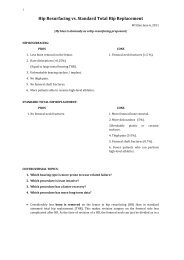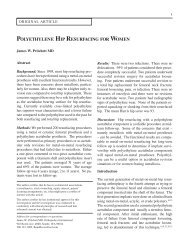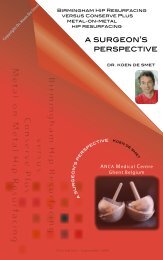Hip and Knee Arthroplasty - Surface Hippy Guide to Hip Resurfacing
Hip and Knee Arthroplasty - Surface Hippy Guide to Hip Resurfacing
Hip and Knee Arthroplasty - Surface Hippy Guide to Hip Resurfacing
You also want an ePaper? Increase the reach of your titles
YUMPU automatically turns print PDFs into web optimized ePapers that Google loves.
PRIMARY TOTAL HIP REPLACEMENT<br />
The analysis for this Report is based on 135,799<br />
primary <strong>to</strong>tal hip replacements reported <strong>to</strong> the<br />
Registry up <strong>to</strong> <strong>and</strong> including 31 st December 2007.<br />
This is an increase of 22,472 primary <strong>to</strong>tal hip<br />
procedures reported in the 2007 Annual Report.<br />
In this category of hip replacement there are<br />
125,004 conventional <strong>to</strong>tal hip replacements,<br />
10,623 <strong>to</strong>tal resurfacing hip replacements <strong>and</strong><br />
172 thrust plate hip replacements.<br />
A complete breakdown of age, gender, primary<br />
diagnosis <strong>and</strong> revision diagnoses for each<br />
category of hip replacement is available in a<br />
supplementary report on the Registry website<br />
www.aoa.org.au/jointregistry_pub.asp.<br />
Diagnosis<br />
Osteoarthritis is the most common diagnosis<br />
associated with primary <strong>to</strong>tal hip replacement<br />
(88.8% of all procedures, 88.3% of conventional<br />
<strong>to</strong>tal, 94.0% of <strong>to</strong>tal resurfacing <strong>and</strong> 94.2% of<br />
thrust plate procedures). Avascular necrosis<br />
(3.8%), fractured neck of femur (3.0%),<br />
developmental dysplasia (1.5%) <strong>and</strong> rheuma<strong>to</strong>id<br />
arthritis (1.4%) account for the majority of other<br />
diagnoses for primary <strong>to</strong>tal hip replacement.<br />
There is some variation in the percentage of<br />
these diagnoses depending on the type of<br />
primary <strong>to</strong>tal hip replacement. Conventional <strong>to</strong>tal<br />
hip replacement is the only primary <strong>to</strong>tal hip<br />
procedure used for the treatment of fractured<br />
neck of femur (3.0% of all primary conventional<br />
<strong>to</strong>tal hip replacements).<br />
Usage<br />
Conventional primary <strong>to</strong>tal hip replacement is the<br />
most common type of primary <strong>to</strong>tal hip<br />
replacement <strong>and</strong> accounts for 92.1% of all<br />
primary <strong>to</strong>tal hips recorded by the Registry.<br />
Total resurfacing accounts for 7.8% <strong>and</strong> thrust<br />
plate for 0.1% of all primary <strong>to</strong>tal hip<br />
replacement (Table HT1).<br />
Last year the Registry reported a decrease in the<br />
proportion of <strong>to</strong>tal resurfacing procedures from<br />
8.8% of all primary <strong>to</strong>tal hip replacements in<br />
2005 <strong>to</strong> 8.3% in 2006. In 2007 <strong>to</strong>tal resurfacing<br />
replacements further declined <strong>to</strong> 7.4% of all<br />
primary <strong>to</strong>tal hip replacements (Figure HT1).<br />
Although there remains considerable regional<br />
variation in the use of <strong>to</strong>tal resurfacing<br />
procedures, all states have shown a reduction in<br />
the use of this procedure. Western Australia <strong>and</strong><br />
Tasmania remain the states with the lowest use<br />
(1.4% <strong>and</strong> 1.9% respectively) (Figure HT1).<br />
The number of thrust plate hip replacement<br />
remains small, with an additional 24 procedures<br />
reported <strong>to</strong> the Registry in 2007.<br />
Primary Conventional Total <strong>Hip</strong><br />
Replacement<br />
In the last five years the Exeter V40 stem has<br />
been the most commonly used femoral stem for<br />
primary conventional <strong>to</strong>tal hip replacement in<br />
Australia (Table HT6 <strong>and</strong> Figure HT4). In 2007<br />
the Corail stem had the second highest usage<br />
followed by the Accolade stem. Four of the five<br />
most frequently used femoral stems are<br />
cementless stems. The percentage of procedures<br />
using the <strong>to</strong>p ten femoral stems has increased<br />
from 63.2% in 2003 <strong>to</strong> 67.4% in 2007. This is<br />
despite an increase in the number of femoral<br />
stems used each year during that period (Table<br />
HT6). The ten most used cemented <strong>and</strong><br />
cementless femoral stems are listed separately in<br />
Tables HT7 <strong>and</strong> HT8.<br />
For the fifth consecutive year the Trident remains<br />
the most frequently used acetabular prosthesis<br />
(Table HT9 <strong>and</strong> Figure HT7). In 2007 the next<br />
most frequently used acetabular prostheses are<br />
the Reflection, Pinnacle <strong>and</strong> Trilogy <strong>and</strong> this has<br />
remained unchanged for the last three years.<br />
The <strong>to</strong>p ten acetabular prostheses were used in<br />
80.9% of all primary conventional <strong>to</strong>tal hip<br />
replacement in 2007. There has been no change<br />
in the number of different types of acetabular<br />
prostheses used in 2007 compared <strong>to</strong> 2006. The<br />
ten most frequently used cemented <strong>and</strong><br />
cementless acetabular prostheses are listed<br />
separately in Tables HT10 <strong>and</strong> HT11.<br />
Primary Total <strong>Resurfacing</strong> <strong>Hip</strong><br />
Replacement<br />
For the second consecutive year the number of<br />
<strong>to</strong>tal resurfacing hip replacements has not only<br />
declined as a proportion of all hip procedures but<br />
also in terms of the absolute number. There was<br />
no change in the number of different types of<br />
<strong>to</strong>tal resurfacing prostheses used in 2007<br />
compared <strong>to</strong> 2006. The 10 most frequently used<br />
<strong>to</strong>tal resurfacing prostheses were used in 99.7%<br />
of all procedures in 2007.<br />
The BHR remains the most used prosthesis<br />
accounting for 54.5% of all <strong>to</strong>tal resurfacing<br />
procedures in 2007. The number of procedures<br />
using this prosthesis has declined in recent years<br />
as a consequence of increased use of other <strong>to</strong>tal<br />
resurfacing systems. The Mitch TRH is now the<br />
second most used <strong>to</strong>tal resurfacing system <strong>and</strong> is<br />
one of the few that has increased in usage. The<br />
53






